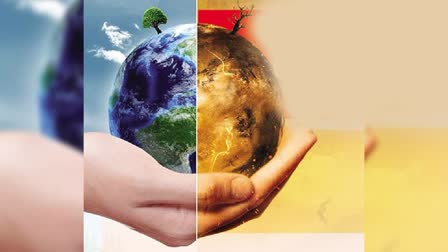Prof. M Raghu of IIT Mumbai said that natural disasters become worse because of climate change. He said that proper early warning mechanisms and disaster management measures can help in handling the situation. Excerpts from an interview to Prof. Raghu follow:
1. What are the causes of extreme heat?
Extreme heat can be a natural seasonal phenomenon. In India, the five months from March to July are warmer followed by cooler temperatures during the monsoons. However, a below normal rainfall or delayed rains can lead to warmer conditions. This can be due to air masses coming from elsewhere like the deserts or the Middle East. There can also be local factors like depression caused by low atmospheric pressure. With climate changes, the chance of extreme weather conditions increase. Thus, an extreme weather condition that happens once in 10 years may happen every three years.
2. Why does climate change cause more heat waves?
Climatic change leads to greenhouse effect in which, Earth's surface acts like a glass, trapping the sun's heat and stopping it from escaping into space. Thus, it causes global warming. For example, the Middle East is warming up and causing winds over the Arabian Sea to get warmer. As a result of which, some parts of India become hotter. The intensity and frequency of heatwaves tend to increase based on the location. The increasing urbanisation and deforestation enhances the conditions to become hotter.
3. Why be concerned about a degree or two change in the average global temperature? What is the impact regionally?
One has to be cautious about the rate of warming in the global context. For example, most of India had cooler weather conditions during 2023 due to local air circulations but one can still experience heatwaves that are conditions happening at the background of the cooling trend. So the local manifestations of global temperature changes have to be understood and predicted on day-to-week timescales. We call these as early warning systems that are provided by the IMD. But the scales at which such warnings are given are too large and it is difficult to assess it at the city or village let alone neighbourhood scale. So, these scales have to be improved though these are already getting better.
4. Is heat wave a natural disaster? What should we do about disaster management?
Of course it's natural disaster but becomes worse in some places due to climate changes. All conditions are now as per a warmer world so everything is affected by climate change. Disaster management has improved a lot but people have to pay attention to the warnings and alerts. Infants, elderly people and those working in the open areas have to be more careful. Also, exposing elderly people to the hotter weather conditions in the name of ceremonies and functions have to be done with caution. There is a need to set up hydration and cooling centres and make hospital accessibility easier.
5. Who is the most at risk from the impact of climate change? Are there any impact studies in India?
All states are not equally vulnerable and both the young and the old are at risk. Farmers, construction workers, street vendors and slum dwellers are more exposed to the extreme weather conditions. Many studies have been done for assessing the socio-economic vulnerability towards natural hazards but all are at the tehsil level. The data required for identifying those who are vulnerable is not available right now and the census data too is not specific. We need to improve these. But the good news is that the overall vulnerability has reduced with reduction of poverty and better education, employment and housing facilities. The National Disaster Management Agency is definitely doing much better compared to a decade ago.
